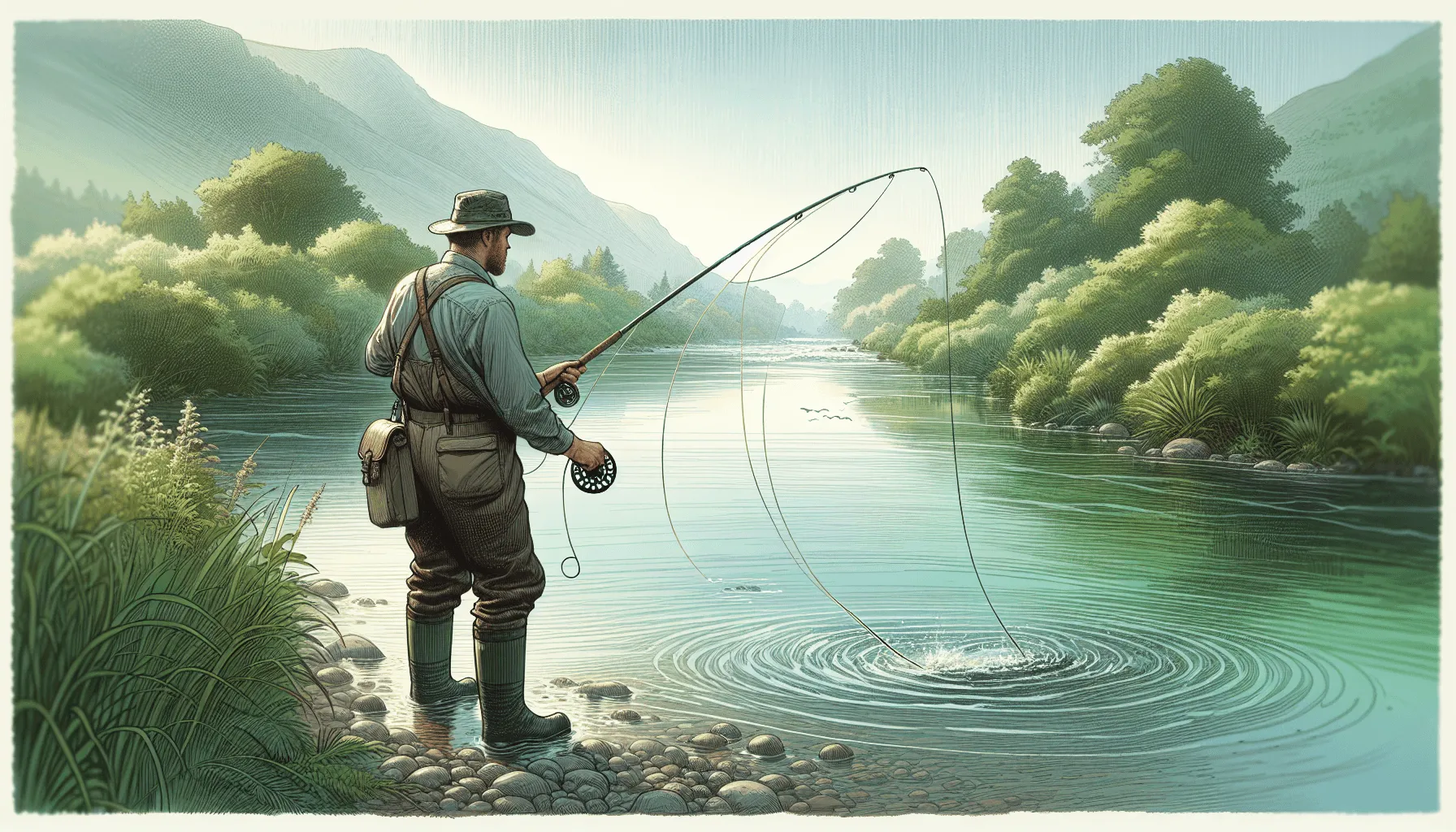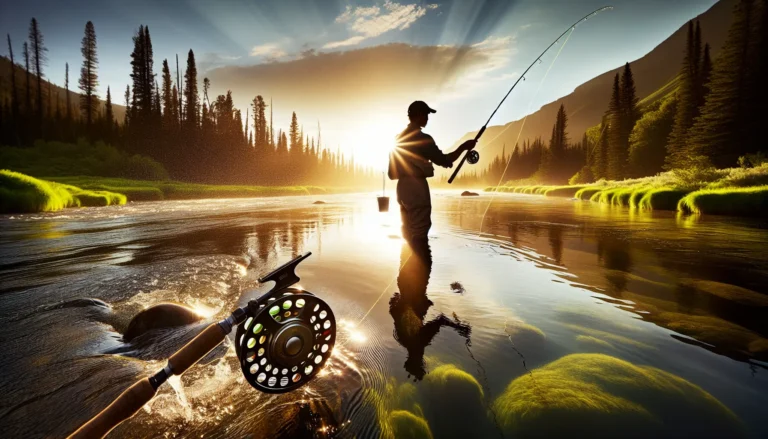What Does Mending the Line Mean in Fly Fishing?
Mending the line in fly fishing means adjusting the fly line and leader on the water to make sure the fly drifts naturally. Anglers do this by moving the line with controlled motions, usually using the rod tip, to lessen or remove drag caused by currents.
Why It’s Important for Anglers:
- Natural Presentation: Mending lets your fly move naturally with the water, making it look like real prey and increasing the chances of a fish bite.
- Longer Drift: Proper mending can extend how long your fly drifts without drag, keeping it in the feeding area longer.
- Better Catch Rate: Good mending reduces unnatural movements that can scare fish away, improving your chances of catching one.
Understanding and mastering this technique is crucial for anglers aiming to increase their efficiency and success rate in various water conditions. Proper mending skills can make a significant difference, transforming an average fishing day into an exceptional one.
Understanding Mending in Fly Fishing
Understanding the concept of mending in fly fishing is crucial for any angler aiming to improve their catch success. Mending involves manipulating the fly line on the water to counteract the effects of varying currents. This is essential to maintain a natural presentation of the fly.
The Role of Controlled Slack
One key aspect of mending is the role of controlled slack. Controlled slack refers to the deliberate creation of slack in the line, which allows the fly to drift naturally with the current. By lifting and repositioning the fly line, you can extend the duration of a drag-free drift, making your fly appear more lifelike to fish.
Achieving a Drag-Free Drift
Mending directly impacts how well you achieve a drag-free drift. Without proper mending, your fly can be affected by drag from conflicting water currents, making it move unnaturally and reducing its effectiveness. By adjusting your line to compensate for these currents, you ensure that your fly stays in the target zone longer and behaves as it would naturally in undisturbed water.
Mastering these elements enhances your ability to present flies effectively, increasing your chances of success on the water. For a deeper dive into understanding mending techniques and how they can help achieve a drag-free drift, it’s worth exploring further resources on these topics.
Types of Mends You Should Know

Understanding the various types of mends is crucial for adapting to different fishing scenarios. Here are some common mending techniques you should be familiar with:
Upstream Mend
Description and Scenarios for Use:
- An upstream mend involves flipping the line upstream after it has landed on the water.
- Ideal when casting across fast water where the current can quickly create drag on your fly.
Techniques and Advantages:
- Lift the rod tip and move it upstream in a smooth motion, creating a loop in the line.
- This technique helps maintain a drag-free drift by allowing the fly to float naturally with the current.
Downstream Mend
Description and Scenarios for Use:
- A downstream mend is executed by flicking the line downstream after casting.
- Useful in slower currents or when targeting fish that are facing upstream.
Techniques and Advantages:
- Lower your rod tip and move it downstream, creating slack in the line.
- This method helps align your fly with the natural flow, making it appear more lifelike to fish.
Water Mend vs Aerial Mend

Water Mend
Description and Scenarios for Use:
- Performed once the line is on the water.
- Suitable for situations where immediate adjustments are needed due to changing currents.
Techniques and Advantages:
- Lift the rod tip subtly and reposition sections of the line without pulling it out of place.
- Allows for quick corrections, making it easier to respond to dynamic water conditions.
Aerial Mend
Description and Scenarios for Use:
- Executed during the cast before the line touches the water.
- Beneficial in avoiding drag from complex current patterns right from the start.
Techniques and Advantages:
- Adjust your casting stroke mid-air to position the line effectively upon landing.
- Offers greater control over initial fly placement, reducing immediate drag effects.
Techniques and When to Apply
- Upstream MendTechnique: Lift rod tip upstream after landing.
- When to Apply: Fast-moving waters where drag occurs quickly.
- Downstream MendTechnique: Lower rod tip downstream post-cast.
- When to Apply: Slow currents or when fish face upstream.
- Water MendTechnique: Subtle adjustments with rod tip once line is on water.
- When to Apply: Dynamic conditions requiring immediate corrections.
- Aerial MendTechnique: Adjust casting stroke mid-air before landing.
- When to Apply: Complex currents needing preemptive alignment.
Mastering these different types of mends will significantly enhance your ability to present flies naturally, adapting seamlessly to various fishing environments. For a visual guide on how to effectively mend your fly line, check out this helpful video tutorial.
Techniques for Effective Line Mending: Mastering the Art
Overview of Basic Techniques for Beginners
Learning how to mend line in fly fishing starts with mastering fundamental techniques. Here are some basic principles:
- Lift and Lay: Lift the rod tip to pick up the line off the water, then lay it back down in a controlled manner. This creates slack without disturbing the fly.
- Roll Cast Mend: Execute a roll cast while mending. This is particularly useful when dealing with obstacles like overhanging branches.
- Reach Mend: During your cast, extend your arm to reach upstream or downstream to position your line correctly before it lands.
Each technique demands practice but offers a solid foundation for effective mending.
Importance of Timing and Rod Movements
Timing and rod movements play a crucial role in effective line mending. Understanding these aspects can drastically improve your success rate:
- Timing: The best moment to mend is right after the fly has landed on the water. Immediate action allows for better control over the drift.
- Rod Movements: Smooth and deliberate rod movements are essential. Quick or jerky actions can spook fish and disrupt the natural drift.
Proper timing combined with controlled rod movements ensures that your fly mimics natural behavior, increasing your chances of a successful catch.
Specific Casting Techniques That Enhance Mending Effectiveness
Certain casting techniques can significantly enhance your mending effectiveness. These methods help you adapt to various fishing scenarios and water conditions:
Aerial Mends
Incorporate mends into your casting motion before the line touches the water. This technique is effective in faster currents where immediate adjustment is needed.
Example: Perform an upstream aerial mend by flicking your wrist upstream during the final forward cast.
Curve Casts
Use curve casts to place your line in a specific configuration on the water, preemptively countering drag.
Example: A left curve cast can create an upstream mend if you’re casting across fast-moving water.
Double Haul Casts
Employ double haul casts to achieve greater distance and accuracy, allowing more precise placement of mends.
Tip: Practice double hauling on flat water to master this advanced technique.
Incorporating these casting techniques into your repertoire can elevate your mending skills, making it easier to present flies naturally in diverse fishing environments.
Mastering these methods may require time and patience but will pay off with improved control over your presentations and increased catch success.
The Role of Mending in Different Fishing Scenarios: Adapting Your Approach
Differences between Mending Techniques for Dry Fly Fishing vs Nymphing
Mending techniques can vary significantly between dry fly fishing and nymphing, each requiring distinct approaches to achieve optimal results.
Dry Fly Fishing
In dry fly fishing, the primary goal is to maintain a natural drift of the fly on the water’s surface. This involves creating a drag-free drift by mending the line to eliminate any unnatural movements. An upstream mend is often employed to counteract currents that may pull the line and cause drag, ensuring the fly floats naturally. The effectiveness of these techniques can be further enhanced by understanding how to drift flies in current, which provides valuable insights into managing your line and maintaining that crucial natural drift.
Nymphing
When nymphing, anglers aim to present their flies below the surface. Mending becomes crucial in controlling the depth and drift of the nymph. Techniques like downstream mends help manage slack in faster currents, allowing the nymph to sink naturally. Additionally, multiple small mends might be necessary to adjust for varying current speeds at different depths.
How Varying Water Conditions Influence Mending Strategies
Adapting your mending techniques based on water conditions is essential for improving success in catching fish while fly fishing.
Fast Currents
In fast-moving waters, maintaining control over your line can be challenging. Upstream mends are typically more effective as they help counteract the force of the current, providing better control over the fly’s drift.
Slow Currents
Slow-moving waters require subtle adjustments. Downstream mends can be beneficial here, as they allow more controlled slack and prevent drag from slower currents. Gentle rod movements ensure that the fly moves naturally with minimal disturbance.
Variable Currents
Waters with mixed current speeds demand a combination of mending techniques. Anglers must assess each section of water and apply appropriate mends—upstream for faster sections and downstream for slower areas—to maintain a consistent, natural presentation.
By understanding these differences and adapting your approach accordingly, you can significantly enhance your effectiveness in various scenarios. Mastering these techniques helps ensure that your flies are presented in a way that mimics natural insect behavior, increasing your chances of success on the water. For more comprehensive guidance on flies and tactics, consider exploring additional resources that delve deeper into these strategies.
Challenges and Solutions in Mastering Mending Skills: Overcoming Obstacles to Success
Common Challenges Faced by Beginners
Beginners often struggle with timing and understanding water dynamics when attempting to mend the line. A frequent issue is the creation of too much slack, which can lead to a loss of control over the fly. Another common problem is improper rod movements that disrupt the drag-free drift, causing the fly to move unnaturally.
Tips and Tricks from Experienced Anglers
Experienced anglers like Landon Mayer and Joe Mahler offer valuable insights for mastering this technique:
- Landon Mayer emphasizes the importance of subtle rod movements. He suggests practicing lifting the rod tip gently and making small, deliberate adjustments to avoid creating excessive slack.
- Joe Mahler advocates for practicing aerial mends during casting. By integrating mending techniques into your casting routine, you can achieve better control over the line before it lands on the water.
Importance of Practice for Refining Skills
Constant practice is crucial for refining your mending skills. Here are some practical exercises:
- Focus on Timing: Practice adjusting your mend based on the speed and direction of the current. This helps in achieving a natural presentation.
- Controlled Slack: Work on creating just enough slack without losing control of the fly. This balance is key for extending the drag-free drift.
- Simulated Conditions: Replicate different water conditions during practice sessions. This prepares you for various real-life scenarios, enhancing adaptability.
Embracing Continuous Learning in Fly Fishing Through Mending Techniques
Keep practicing these mending techniques to see improvements in your fly fishing skills!
Conclusion: Embracing Continuous Learning in Fly Fishing Through Mending Techniques
Understanding what does mending the line mean in fly fishing is crucial for any angler aiming to improve their success on the water. Practicing mending techniques can significantly enhance your ability to present flies naturally, leading to better results.
Mending helps achieve a drag-free drift, allowing flies to move with the current naturally.
Mastering mending is essential for adapting to various water conditions and increasing your catch rate.
Keep refining your skills through practice, learning from experienced anglers, and embracing continuous improvement.
FAQs (Frequently Asked Questions)
What does mending the line mean in fly fishing?
Mending the line in fly fishing refers to the technique of adjusting the position of your fly line to create a more natural presentation of the fly. This is crucial for achieving a drag-free drift, which enhances your chances of catching fish.
Why is mending important in fly fishing?
Mending is significant because it allows anglers to control the slack in their line, which helps to present the fly more naturally to fish. Proper mending can greatly improve catch success by minimizing drag and ensuring that the fly behaves like a real insect.
What types of mends should I know?
There are several types of mends you should be familiar with, including upstream mend, downstream mend, water mend, and aerial mend. Each type has its specific techniques and scenarios for use, allowing anglers to adapt their approach based on conditions.
What are some techniques for effective line mending?
Effective line mending involves mastering basic techniques such as timing and rod movements. Specific casting techniques can enhance your mending effectiveness, allowing for better control over how your line interacts with the water.
How does mending differ between dry fly fishing and nymphing?
The approach to mending varies between dry fly fishing and nymphing due to differences in how each method presents flies. Understanding these differences and adapting your mending strategies according to varying water conditions can significantly improve your success rate.
What challenges might I face when mastering mending skills?
Common challenges include timing issues and understanding water dynamics that affect drag-free drift. Tips from experienced anglers emphasize the importance of practice and offer solutions to overcome these obstacles, ultimately refining your skills in mending.




